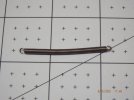I’ve owned numerous BM’s over several years, and I’ve never broken an omega spring. Not denying it happens, because it apparently does. That said, I’ve noticed over the last couple of years it seems the reports are more widespread among Bugouts, smaller models like the 940, and “mini” models. Aside from a 940 or two, which I had no issues with, I’ve personally never owned a Bugout or a “mini” model of anything. I wonder if it has anything to do with the smaller diameter of the curl of the springs in those models, and/or possibly the propensity of owners of such models to fidget with them more because they’re small. Strictly an observation, nothing data-driven, scientific, or even judgy applied.


